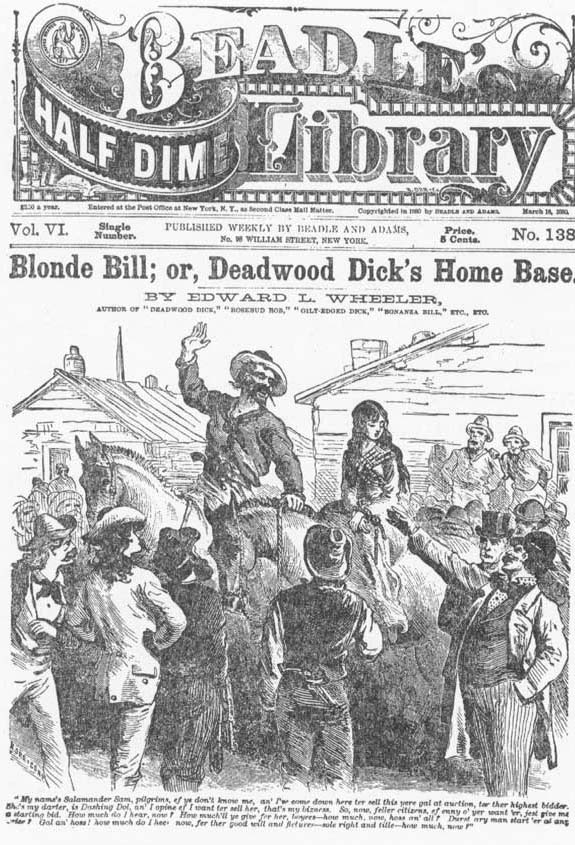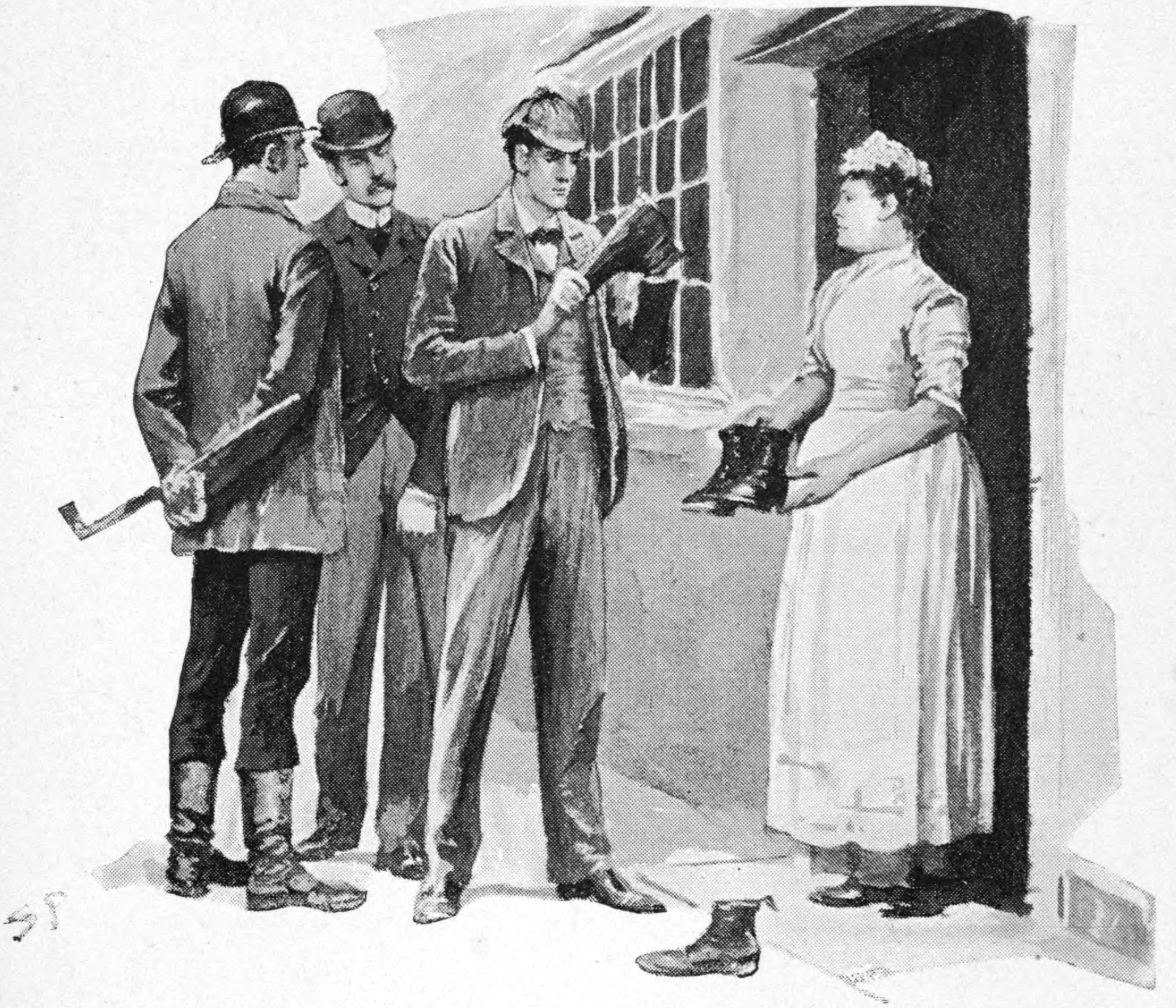|
Denver Doll
''Denver Doll'' is a fictional character created by Edward Lytton Wheeler, author of the Deadwood Dick Deadwood Dick is a fictional character who appears in a series of stories, or dime novels, published between 1877 and 1897 by Edward Lytton Wheeler (1854/5–1885). The name became so widely known in its time that it was used to advantage by s ... dime novels.Beadle's Half-Dime Library, Vol. XI. No. 277, November 14, 1882, "Denver Doll the Detective Queen; or, Yankee Eisler's Big Surround" She originally appeared in four novels in ''Beadle's Half-Dime Library'', which were reprinted in the ''Beadle's Pocket Library'', ''Deadwood Dick Library'' and in ''Aldine Boys' First-Rate Pocket Library'' in England. Denver Doll was the first complete American female detective novel. ''Denver Doll the Detective Queen'' by Joseph Lovece, Createspace, 2014, www.amazon.com/Denver-Detective-Queen-Revival-Volume/dp/149971646X/ The first American lady detective to appear in print was Lady Ka ... [...More Info...] [...Related Items...] OR: [Wikipedia] [Google] [Baidu] |
Edward Lytton Wheeler
Edward Lytton Wheeler (1854/5 – 1885) was a nineteenth century American writer of dime novels. One of his most famous characters is the Wild West rascal Deadwood Dick. His stories of the west mixed fictional characters with real-life personalities of the era, including Calamity Jane and Sitting Bull. Life Wheeler was born in Avoca, New York and later managed a theater company in Philadelphia. He created the seminal character of Deadwood Dick, during a period when the country was fascinated by the Black Hills region of the American west after Custer’s defeat at Little Bighorn. Wheeler had never been to the Black Hills. He originally created Deadwood Dick as a character for his theater troupe, and later made him the focus of a dime novel series. The first episode was the first issue of Beadles Half-dime Library. After the Civil War, dime novels were an extremely popular form of fiction. Wheeler mastered their formulaic style and was able to write dozens of them. He created a ... [...More Info...] [...Related Items...] OR: [Wikipedia] [Google] [Baidu] |
Western (genre)
The Western is a genre Setting (narrative), set in the American frontier and commonly associated with Americana (culture), folk tales of the Western United States, particularly the Southwestern United States, as well as Northern Mexico and Western Canada. It is commonly referred to as the "Old West" or the "Wild West" and depicted in Western media as a hostile, sparsely populated frontier in a state of near-total lawlessness patrolled by outlaws, sheriffs, and numerous other Stock character, stock "gunslinger" characters. Western narratives often concern the gradual attempts to tame the crime-ridden American West using wider themes of justice, freedom, rugged individualism, Manifest Destiny, and the national history and identity of the United States. History The first films that belong to the Western genre are a series of short single reel silents made in 1894 by Edison Studios at their Edison's Black Maria, Black Maria studio in West Orange, New Jersey. These featured vet ... [...More Info...] [...Related Items...] OR: [Wikipedia] [Google] [Baidu] |
Detective Fiction
Detective fiction is a subgenre of crime fiction and mystery fiction in which an investigator or a detective—whether professional, amateur or retired—investigates a crime, often murder. The detective genre began around the same time as speculative fiction and other genre fiction in the mid-nineteenth century and has remained extremely popular, particularly in novels. Some of the most famous heroes of detective fiction include C. Auguste Dupin, Sherlock Holmes, and Hercule Poirot. Juvenile stories featuring The Hardy Boys, Nancy Drew, and The Boxcar Children have also remained in print for several decades. History Ancient Some scholars, such as R. H. Pfeiffer, have suggested that certain ancient and religious texts bear similarities to what would later be called detective fiction. In the Old Testament story of Susanna and the Elders (the Protestant Bible locates this story within the apocrypha), the account told by two witnesses broke down when Daniel cross-examines th ... [...More Info...] [...Related Items...] OR: [Wikipedia] [Google] [Baidu] |
Deadwood Dick
Deadwood Dick is a fictional character who appears in a series of stories, or dime novels, published between 1877 and 1897 by Edward Lytton Wheeler (1854/5–1885). The name became so widely known in its time that it was used to advantage by several men who actually resided in Deadwood, South Dakota. Those who took the nickname included: * Frank Palmer, gambler, according to his obituary of May 30, 1906, was the original "Deadwood Dick" who, at the age of 17 (c. 1879) went west from Springfield, Illinois, to Deadwood, South Dakota, where he made his fortune playing games of chance. He was dubbed "Deadwood Dick" by fellow gamblers. Palmer was the hero of Beadle's half-dime novels. * Nat Love (1854–1921), an African-American cowboy; * Dick Brown, an actor; * Richard Cole, a stage coach driver; * Richard Clarke, also an actor; the Deadwood Chamber of Commerce asked him in 1927 to portray Deadwood Dick in the city's annual Days of '76 Parade. Clarke's work was managed by public ... [...More Info...] [...Related Items...] OR: [Wikipedia] [Google] [Baidu] |
The Steam Man Of The West
''The'' () is a grammatical article in English, denoting persons or things that are already or about to be mentioned, under discussion, implied or otherwise presumed familiar to listeners, readers, or speakers. It is the definite article in English. ''The'' is the most frequently used word in the English language; studies and analyses of texts have found it to account for seven percent of all printed English-language words. It is derived from gendered articles in Old English which combined in Middle English and now has a single form used with nouns of any gender. The word can be used with both singular and plural nouns, and with a noun that starts with any letter. This is different from many other languages, which have different forms of the definite article for different genders or numbers. Pronunciation In most dialects, "the" is pronounced as (with the voiced dental fricative followed by a schwa) when followed by a consonant sound, and as (homophone of the archaic pron ... [...More Info...] [...Related Items...] OR: [Wikipedia] [Google] [Baidu] |
Characters In Dime Novels
Character or Characters may refer to: Arts, entertainment, and media Literature * ''Character'' (novel), a 1936 Dutch novel by Ferdinand Bordewijk * ''Characters'' (Theophrastus), a classical Greek set of character sketches attributed to Theophrastus Music * ''Characters'' (John Abercrombie album), 1977 * ''Character'' (Dark Tranquillity album), 2005 * ''Character'' (Julia Kent album), 2013 * ''Character'' (Rachael Sage album), 2020 * ''Characters'' (Stevie Wonder album), 1987 Types of entity * Character (arts), an agent within a work of art, including literature, drama, cinema, opera, etc. * Character sketch or character, a literary description of a character type * Game character (other), various types of characters in a video game or role playing game ** Player character, as above but who is controlled or whose actions are directly chosen by a player ** Non-player character, as above but not player-controlled, frequently abbreviated as NPC Other uses in art ... [...More Info...] [...Related Items...] OR: [Wikipedia] [Google] [Baidu] |
Characters In Pulp Fiction
Character or Characters may refer to: Arts, entertainment, and media Literature * ''Character'' (novel), a 1936 Dutch novel by Ferdinand Bordewijk * ''Characters'' (Theophrastus), a classical Greek set of character sketches attributed to Theophrastus Music * ''Characters'' (John Abercrombie album), 1977 * ''Character'' (Dark Tranquillity album), 2005 * ''Character'' (Julia Kent album), 2013 * ''Character'' (Rachael Sage album), 2020 * ''Characters'' (Stevie Wonder album), 1987 Types of entity * Character (arts), an agent within a work of art, including literature, drama, cinema, opera, etc. * Character sketch or character, a literary description of a character type * Game character (other), various types of characters in a video game or role playing game ** Player character, as above but who is controlled or whose actions are directly chosen by a player ** Non-player character, as above but not player-controlled, frequently abbreviated as NPC Other uses in art ... [...More Info...] [...Related Items...] OR: [Wikipedia] [Google] [Baidu] |
Fictional American Police Detectives
Fiction is any creative work, chiefly any narrative work, portraying individuals, events, or places that are imaginary, or in ways that are imaginary. Fictional portrayals are thus inconsistent with history, fact, or plausibility. In a traditional narrow sense, "fiction" refers to written narratives in prose often referring specifically to novels, novellas, and short stories. More broadly, however, fiction encompasses imaginary narratives expressed in any medium, including not just writings but also live theatrical performances, films, television programs, radio dramas, comics, role-playing games, and video games. Definition Typically, the fictionality of a work is publicly marketed and so the audience expects the work to deviate in some ways from the real world rather than presenting, for instance, only factually accurate portrayals or characters who are actual people. Because fiction is generally understood to not fully adhere to the real world, the themes and con ... [...More Info...] [...Related Items...] OR: [Wikipedia] [Google] [Baidu] |
Literary Characters Introduced In 1882
Literature is any collection of written work, but it is also used more narrowly for writings specifically considered to be an art form, especially prose fiction, drama, and poetry. In recent centuries, the definition has expanded to include oral literature, much of which has been transcribed. Literature is a method of recording, preserving, and transmitting knowledge and entertainment, and can also have a social, psychological, spiritual, or political role. Literature, as an art form, can also include works in various non-fiction genres, such as biography, diaries, memoir, letters, and the essay. Within its broad definition, literature includes non-fictional books, articles or other printed information on a particular subject.''OED'' Etymologically, the term derives from Latin ''literatura/litteratura'' "learning, a writing, grammar," originally "writing formed with letters," from ''litera/littera'' "letter". In spite of this, the term has also been applied to spoken or sun ... [...More Info...] [...Related Items...] OR: [Wikipedia] [Google] [Baidu] |
Female Characters In Literature
Female (symbol: ♀) is the sex of an organism that produces the large non-motile ova (egg cells), the type of gamete (sex cell) that fuses with the male gamete during sexual reproduction. A female has larger gametes than a male. Females and males are results of the anisogamous reproduction system, wherein gametes are of different sizes, unlike isogamy where they are the same size. The exact mechanism of female gamete evolution remains unknown. In species that have males and females, sex-determination may be based on either sex chromosomes, or environmental conditions. Most female mammals, including female humans, have two X chromosomes. Female characteristics vary between different species with some species having pronounced secondary female sex characteristics, such as the presence of pronounced mammary glands in mammals. In humans, the word ''female'' can also be used to refer to gender in the social sense of gender role or gender identity. Etymology and usage The ... [...More Info...] [...Related Items...] OR: [Wikipedia] [Google] [Baidu] |
Midwestern United States In Fiction
The Midwestern United States, also referred to as the Midwest or the American Midwest, is one of four census regions of the United States Census Bureau (also known as "Region 2"). It occupies the northern central part of the United States. It was officially named the North Central Region by the Census Bureau until 1984. It is between the Northeastern United States and the Western United States, with Canada to the north and the Southern United States to the south. The Census Bureau's definition consists of 12 states in the north central United States: Illinois, Indiana, Iowa, Kansas, Michigan, Minnesota, Missouri, Nebraska, North Dakota, Ohio, South Dakota, and Wisconsin. The region generally lies on the broad Interior Plain between the states occupying the Appalachian Mountain range and the states occupying the Rocky Mountain range. Major rivers in the region include, from east to west, the Ohio River, the Upper Mississippi River, and the Missouri River. The 2020 United St ... [...More Info...] [...Related Items...] OR: [Wikipedia] [Google] [Baidu] |




.png)

